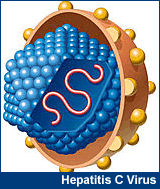HCV
Re-infection Common among HIV+ Gay Men in Amsterdam
 |
 |
 |
 |
| SUMMARY:
More than 25% of HIV positive men treated for acute hepatitis
C in Amsterdam became re-infected within about 1 year, indicating
the need for better prevention efforts, researchers reported
at CROI 2011. |
|
 |
 |
 |
 |
By
Liz Highleyman
 Starting
around 2000 clinicians began reporting cases of apparently sexually
transmitted acute hepatitis C virus (HCV) infection among HIV positive
gay and bisexual men. These reports first came from the U.K., followed
by major cities in Europe, Australia, and the U.S.
Starting
around 2000 clinicians began reporting cases of apparently sexually
transmitted acute hepatitis C virus (HCV) infection among HIV positive
gay and bisexual men. These reports first came from the U.K., followed
by major cities in Europe, Australia, and the U.S.
On average,
HIV/HCV coinfected people experience more rapid liver disease progression
and do not respond as well to interferon-based
hepatitis C treatment. But whether HIV
positive or negative, treatment is more effective if started during
acute infection. Unlike some other diseases, however, HCV
infection does not confer immunity, and people can become infected
multiple times.
As reported
at the 18th Conference on Retroviruses and Opportunistic Infection (CROI
2011) last month in Boston, Femke Lambers from the Amsterdam Public
Health Service and colleagues looked at HCV re-infection among HIV positive
gay/bisexual men diagnosed and treated for sexually transmitted acute
hepatitis C at a city HIV outpatient clinic.
Some data
suggest HCV infection within this population has leveled off -- stabilizing
at around 15% -- but the rate of re-infection after successful treatment
is unknown.
The researchers looked at outcomes among patients who had undetectable
HCV RNA viral load at the end of treatment with interferon-based therapy
started during acute infection. Since most relapses occur within 2 months
after completion of treatment, they defined HCV re-infection as having
a positive HCV RNA test after having had a negative test at least 2
months after completing therapy.
To further rule out relapses, the researchers decided to only count
cases in which patients had a different new HCV genotype, clade, or
strain. The median follow-up period was about 1 year and the median
interval between tests was 2.7 months.
Results
 |
During
treatment for the first case of acute HCV, 28 men became HCV RNA
negative and remained so until at least 2 months after the end of
therapy. |
 |
Within
2 months after treatment completion, 2 of the 28 men presumably
relapsed and were omitted from the analysis. |
 |
According
to the researchers' definition, 7 of the 26 men who were followed
beyond 2 months after treatment experienced HCV re-infection. |
 |
All
re-infections occurred within 2 years. |
 |
The
resulting incidence rate of HCV re-infection in this group was 19.6
per 100 person-years. |
 |
This
rate is about 10 times higher than the initial HCV infection rate
among HIV positive gay/bisexual men in Amsterdam. |
 |
Most
men switched from HCV genotype 1 to 4 or vice versa (genotype 4
is uncommon in Europe outside the HIV/HCV coinfection clusters among
gay men). |
"Despite
high clearance rates and a possible decrease in incidence of primary
HCV infection among HIV+ [men who have sex with men] in Amsterdam, an
alarmingly high incidence of HCV re-infection was found in this group,"
the investigators concluded.
This high re-infection rate "indicates that prevention measures
should not only be discussed early after diagnosis, but also during
and after treatment," they advised. Furthermore, they added, "regular
HCV RNA testing should be continued early after successful treatment."
Investigator affiliations: Public Health Service, Amsterdam, Netherlands;
Academic Medical Center, Amsterdam, Netherlands.
4/8/11
Reference
F
Lambers, M Prins, X Thomas, et al. High Incidence Rate of HCV Reinfection
after Treatment of Acute HCV Infection in HIV+ MSM: Amsterdam. 18th
Conference on Retroviruses and Opportunistic Infections (CROI 2011).
Boston. February 27-March 2, 2011. Abstract
958.